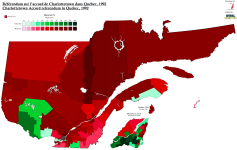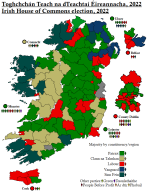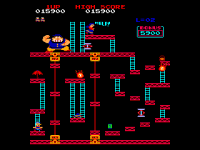Northern Ireland Forum
prime-minister
Average electoral map enjoyer
- Location
- Cambridge
- Pronouns
- They/them
Sorry I've been absent for a while, but I made a little thing since it was Good Friday the other day.

The Northern Ireland Forum is one of the four often-forgotten precursors to the NI Assembly set up during the Troubles, and was the one which represented the province in the run-up to the Good Friday Agreement. It was set up to deliberate the agreement's provisions, though it quite deliberately had no power over legislation or the negotiations whatsoever.
Probably the two most interesting things about it (and the reason I mapped it instead of the first Assembly election, though I might do that another time) are to do with its electoral system. First, unlike basically every other election on the island, neither FPTP nor STV were used- instead, D'Hondt method PR was used to elect seats in the constituencies, which were based on the boundaries drawn up for the 1997 election and elected 5 members each. The part about the new boundaries is notable because the 1982 election had used the old ones despite the then-new ones being ready, and this had made voters very cross about the pointless disparity.
Second, it had a quite unusual top-up seat system where all of the 10 largest parties got 2 seats each, no matter how many votes they got. This was done quite deliberately to guarantee that the minor Loyalist paramilitary parties would get admitted to the Assembly as well as Sinn Fein, and led to some quite unusual participating parties in the Forum.
Along with the usual suspects (the funny part is I typed that and suddenly remembered that one Derry Girls episode where the adults are desperate to work out who Keyser Söze is), who won all the constituencies seats except one in North Down which elected Robert McCartney of the UK Unionists, because North Down, you also had:

The Northern Ireland Forum is one of the four often-forgotten precursors to the NI Assembly set up during the Troubles, and was the one which represented the province in the run-up to the Good Friday Agreement. It was set up to deliberate the agreement's provisions, though it quite deliberately had no power over legislation or the negotiations whatsoever.
Probably the two most interesting things about it (and the reason I mapped it instead of the first Assembly election, though I might do that another time) are to do with its electoral system. First, unlike basically every other election on the island, neither FPTP nor STV were used- instead, D'Hondt method PR was used to elect seats in the constituencies, which were based on the boundaries drawn up for the 1997 election and elected 5 members each. The part about the new boundaries is notable because the 1982 election had used the old ones despite the then-new ones being ready, and this had made voters very cross about the pointless disparity.
Second, it had a quite unusual top-up seat system where all of the 10 largest parties got 2 seats each, no matter how many votes they got. This was done quite deliberately to guarantee that the minor Loyalist paramilitary parties would get admitted to the Assembly as well as Sinn Fein, and led to some quite unusual participating parties in the Forum.
Along with the usual suspects (the funny part is I typed that and suddenly remembered that one Derry Girls episode where the adults are desperate to work out who Keyser Söze is), who won all the constituencies seats except one in North Down which elected Robert McCartney of the UK Unionists, because North Down, you also had:
- the Progressive Unionist Party (PUP), a unionist paramilitary party with ties to the UVF who evolved out of working-class Protestantism into basically the only outwardly left-wing unionist party. It was sort of a weird mirror of Sinn Fein- it evolved from a militant group into one which supported the Good Friday Agreement, but unlike Sinn Fein it never truly cut ties with the paramilitary forces. Even so, its members of the Forum, David Ervine and Hugh Smyth, were outspoken progressives.
- the Ulster Democratic Party (UDP), a Protestant party aligned with the UDA which quickly went a bit loopy, first calling for Northern Irish independence from both the UK and Ireland and then going all in on calling for devolution and a Bill of Rights. Its elected members were Gary McMichael, who went all in on ceasefire and the Good Friday Agreement, and John White, whose priority over politics was allegedly drug-dealing.
- The Northern Ireland Women's Coalition (NIWC), a cross-community group which waffled on the nationalism question (and feminism, ironically) but was fairly influential in helping challenge attitudes to women in politics in the region. One of its co-leaders and Forum members, Monica McWilliams, is credited as having helped secure restitution for victims and a civic forum, and she would win election to the Assembly in 1998.
- the Labour Coalition, listed as just 'Labour', made up of a group of small defecting parties from the SDLP. I think they were nationalist-aligned, but it's a bit hard to tell. The two members elected to the Forum would later set up the 'Labour Party of Northern Ireland', which is a huge rabbit hole of a name with how many times it's been used by completely unconnected groups and gone nowhere.
Last edited:






